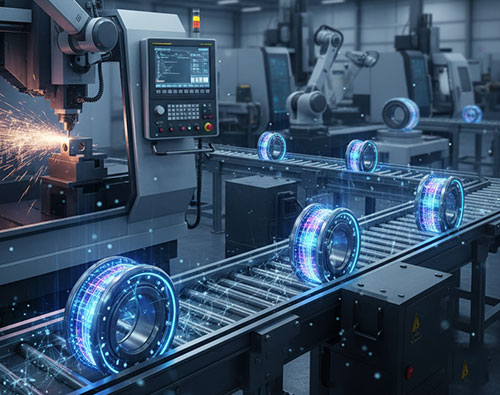
Today’s industry scene sees big change. Industry 4.0 redefines manufacturing and AI has become a cornerstone of modern production. Machine tools can think less just gears, more smart gizmos with data smarts now.
Think about it those at one time was simple tapered roller bearing components are now getting a final upgrade in design, performance, and preservation via forward-thinking engineering and AI integration.
AI plus best engineering that’s pushing manufacturing toward a future where things get supremely well-organized adapt super quick and yeah accuracy's off charts.
Machine tools have traditionally been the most important part of making anything. They form the physical base of everything we use by milling, grinding, drilling, and turning. AI is making it easier to make, watch after, and keep these bearings in good shape today. Data-driven understandings are surprisingly being used to advance the entire strategy and functionality of Tapered roller bearing in country like India and all over the globe.
AI-driven machine tools at present mix IoT sensors, digital twins, and advantage computing, that lets them to check tool wear, notice anomalies, and create self-directed adjustments in real time. For instance, sensors entrenched in bars and bearings can give vibration, temperature, and torque dissimilarities.
The data got together is examined making use of AI algorithms to expect failures before they take place, stopping expensive stoppage. In the context of tapered roller bearings, it is initial identification of misalignment, lubrication problems, or overload circumstances that can otherwise go overlooked till failure.
Digital twin technology is another important part of AI-driven progress. A digital twin is a virtual copy of a physical system, such a machine tool or a bearing assembly, that shows how it works in real time by constantly sending data back and forth.
Engineers can mimic processes, test settings, and anticipate consequences without stopping real production. Factories that do the best in the Industry 4.0 age are the ones that use both AI and expert human decision.
For instance, a digital twin may show how the loads on the bearings would change as the cutting speed or tool pressure changes on a CNC machine using tapered roller bearings. It can also guess how various lubricants or bearing materials would work in certain situations. This not only makes designs more accurate, but it also helps find the best machine tool setups for longer bearing life and smoother performance.
AI is just not altering the way bearings are watched it’s transforming how its created. In forward-thinking bearing manufacture facilities, AI-powered check-up methods use computer vision to see micro-defects in rollers, birdcages, and channels with consummate precision.
Machine learning models are made to see errors that human assessors can even overlook, making sure it is reliable quality and lessening surplus. AI-driven process control also helps improve machining tasks like grinding and heat treatment. These steps are very important for determining how well tapered roller bearings work.
AI looks at things like temperature differences, cutting speed, and pressure to keep everything perfectly aligned and smooth. This prevents premature tiredness and makes the machine more energy efficient.
For bearings and machine tools adopting AI, predictive maintenance sure seems like a game changer. Classic maintenance? It's planned or post-breakdown both kind wasteful routes. AI helps predict maintenance changing things completely.
Think about putting sensors inside bearing areas or near machine parts; they constantly grab live info about machine wobble, how much stress there is, temperature, and if lubrication is good. AI scans data, spotting wear hints imbalances real trouble starts.
For maintenance teams, cloud dashboards send alerts so they can step in only when things really need attention. It cuts surprise breakdowns while helping equipment last. For tapered roller bearings having this skill predicting failures can especially valuable. Because bearings frequently work under heavy loads and fast speeds detecting stress or lube failures quickly?
Vital, or equipment breaks can occur. AI can see trouble coming and suggests how you might fix it like tweaking oil or spreading weight for best results.
AI working alongside machine tools and bearings from Decbearing is a big shift for industry. It used to be just machines turning now data fuels how things run plus careful looks ahead boost dependability; true to you. AI's changed up how factories work, from making stuff more exact to helping predict fixes and letting users build digital versions.
Industry 4.0 gets deeper so smart tech and mechanical engineering will probably just keep pushing limits. So, for engineers say manufacturers and leaders in industry question now becomes less about if AI gets used but how fast power gets harnessed building future factories true to you.